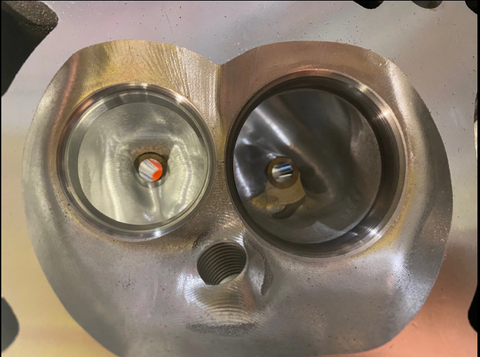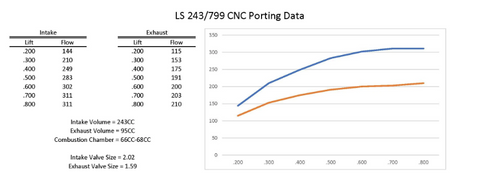
The LS engine by General Motors came in seven different versions, and the majority of them had different heads. The head names are indicated by the stamp next to the valve cover that shows the three-digit number.
The 243 heads came on the powerful LS6 engines from 2001 to 2006. Although the heads were initially made for C5 Corvettes, they later found their use in engines like the truck-spec LQ9 and LQ4. The LQ4 and LQ9 had 6 cc larger combustion chambers.
LS6 was also used in some Camaros and Pontiac GTOs.
The 243 heads are cast out of aluminum alloy, and they feature reshaped intake ports and D-shaped exhaust ports offering high performance and efficiency.
They also have higher-lift camshafts, stronger valve train, and other improvements that allow improved airflow, offering greater horsepower.
The 243 heads come with 1.7 - ratio rockers responsible for opening and closing the intake and exhaust valves. The configuration is different from the 1.8 ratios found on most other LS heads. The main benefit of this is that it allows for greater lift, which results in more airflow and more power.
If you want to buy 243 LS heads, Allied Motor Parts is just the place for it. Get in touch today.
Highlighting Features of 243 LS Heads
The LS6 had a stiff valve train coupled with an aggressive camshaft that made it perfect for the Corvettes at the time. But what makes 243 LS heads special is their ability to fit into different makes and models, making it a great example of the modular approach that GM is popular for.
Let’s delve into the highlighting features of 243 heads with the LS6 engines:
Cylinder Block
The cylinder block is the foundation of the engine. It's where the pistons, rods, and crankshaft are housed. The cylinder block is also where you'll find the oil pan and water jacket.
The 243 cylinder heads are 3rd generation cylinder heads by GM. The LS6 cylinder block has many similarities with the small-block V8, such as a 4.4-inch bore center and a 90-degree cylinder angle.
Rotating Assembly

The LS6's durable rotating assembly includes a cast-iron crankshaft and powder metal connecting rods with an I-beam design, commonly found in the LS1 engine.
The pistons are made from cast aluminum and have a hyper eutectic design. As a result, the LS6's stroke is 3.62 inches shorter than the V8's 4-inch stroke. It helps to create more torque at lower RPMs.
Meanwhile, the compression ratio of the LS6 is 10:1, which is higher than the V8's 9.6:1 compression ratio. As a result, it helps the engine to produce more power.
Cylinder Heads
The cylinder heads are responsible for housing the intake and exhaust valves. They also have combustion chambers where the air/fuel mixture is combusted.
The 243 cylinder heads are made of aluminum with steel intake. The exhaust valves are at a 15-degree angle to maximize airflow. Other components of the 243 cylinder heads are roller-pivot rocker arms and beehive valve springs.
- Roller-Pivot Rocker Arms: A rocker arm is a lever that transfers motion from the camshaft to the valves. The LS6's rocker arms are made of investment-cast nodular iron, with a 1.7:1 ratio. They also have needle roller bearings to minimize friction.
- Beehive Valve Springs: The beehive valve springs increase valve train stability at high RPMs. They are made of chrome silicone, and they can handle a lift of up to 0.550 inches.
Engine Management
The engine management system is responsible for controlling the air/fuel mixture, ignition timing, and idle speed. It does this by using sensors that monitor various engine parameters.
The LS6 engine is managed by the Engine Control Module (ECM). The ECM uses information from the following sensors:
- Crankshaft position sensor
- Throttle position sensor
- Mass airflow sensor
- Oxygen sensor
- Coolant temperature sensor
The ECM uses this information to make real-time adjustments to the air/fuel mixture and ignition timing. Thus, it helps optimize engine performance and fuel economy.
Camshaft Design
The camshaft is responsible for converting rotational motion to reciprocal motion.
The LS6 engine works with a hydraulic roller-lifter camshaft. Like LS1, LS6 also received 2 different cam specifications based on the applications and model year.
The differences in LS6 - 2001 Corvette Z06 cam specs vs. LS6 - 2002-2004 Z06 cam specs are:
- 0.525/0.525-intake/exhaust lift vs. 0.555/0.551-intake/exhaust lift
- 116-degree cam angle lobe separation vs. 117.5-degree cam angle lobe separation
204/211-crank angle degrees intake/exhaust duration vs. 204/218-crank angle degrees intake/exhaust duration ( both at 0.050 tappet lift)
Inlet/Intake Manifold
The intake manifold is responsible for delivering the air/fuel mixture to the cylinders. It has a cast aluminum build and a runner length of 12 inches.
The intake manifold has a lower plenum and an upper plenum. The lower plenum is where the air enters the manifold, while the upper plenum is where the air/fuel mixture is distributed to the cylinders.
The intake manifold in 243 LS heads has 30-pound-per-hour fuel injectors. This intake manifold configuration later became the standard for LS1 243 heads due to their effectiveness.
24x Ignition System
All LS6 engines have a 24x crankshaft reluctor wheel. The wheel maintains a consistent relationship between the crankshaft position and the ECM. As a result, the ECM can provide accurate ignition timing control.
The LS6 also has a coil-near-plug ignition system. It means that there is one coil for each spark plug. The coil-near-plug ignition system is more efficient than the conventional distributor ignition system. As a result, it helps to improve engine performance and fuel economy.
Exhaust System
The exhaust system removes the combustion gases from the cylinders. It consists of the following parts:
- Exhaust manifold
- Catalytic converter
- Muffler
The LS6 exhaust manifold is a “four-into-one” short-header exhaust manifold made of cast iron. It has a cross-over design, and it is connected to the catalytic converter with a stainless steel pipe.
The catalytic converter is responsible for reducing emissions.
The muffler is located at the end of the exhaust system and helps in noise reduction. The LS6 engines have the same exhaust manifolds as their LS1 counterparts.
Difference Between LS6 and LS1
If you're planning to buy LS6 243 heads, you should know how they differ from the LS1 configuration. There are three main differences between both engines.
- Port Shape: The port shape of both heads is different. The LS6 has a reshaped intake and D-shaped exhaust port that facilitates a better flow - 210 cfm intake and 75 cfm exhaust. Meanwhile, the LS 241s have an oval-shaped exhaust port that offers 200 cfm intake and 70 cfm exhaust.
- Valve System: The ported 243 heads have a sodium-filled, hollow valve system. It lowers the inertia of the valve train. However, this design is lacking in the 241 heads.
- Combustion Chamber: The combustion chamber in 243 heads is 65cc, while 241s has a 67cc combustion chamber. Due to this, the 243 heads have a higher compression ratio.
When looking for the ideal heads to pair with your LS engine, it is important to consider the airflow potential, port shape, and valve system. For example, the 243 heads offer better airflow, port shape, and valve system than 241s.
Purchasing 243 Heads
Purchasing 243 heads can be daunting because many vendors sell fake or used parts. Therefore, it is vital to buy your heads from a reputable vendor to ensure that you're getting a quality product.
Moreover, make sure you compare the head types to find the best one for your needs. At Allied Motor Parts, we provide 243 heads for sale. So whether you're looking for CNC ported 243 heads or Chevy 243 heads, we've got them all. We also offer a wide range of other LS performance parts.

Allied Motor Parts is the leading provider of LS performance parts. We have a team of experts that can help you choose the correct parts for your vehicle. Contact us today to learn more about our products, services and for remanufactured cylinder heads.
Frequently Asked Questions:
Which LS engines have 243 heads?
The LS6 engines from 2001-2006 have 243 heads. The LS motor with 243 heads is more powerful and efficient.
GM’s 243 heads were typically found in C5 Corvette and later on engines like truck specs LQ4 and LQ9.
How much Horsepower (HP) is added by 243 heads?
A pair of 243 heads adds about 20 horsepower (hp) to the LS1 or LS6 engine.
Hence, ported 243 heads with improved intake and exhaust ports will give your vehicle greater airflow, which adds up to more horsepower.
What is special about 243 heads?
The 243 heads deliver increased performance and extra boost - a flow boost of up to 32.2 cfm and 28.5 cfm on the intake and exhaust ports and a horsepower boost of up 20 hp.
Its superior casting and better airflow, along with incredible design, make it a desirable choice.
Are 243 heads Cathedral port?
Yes, 243 LS heads have Cathedral shaped intake port and D-shaped exhaust port. The intake port has smaller chambers than its counterpart, which helps to enhance air and fuel intake, smooth combustion, and quicker exhausting.
Related Products of 243 Cylinder Heads:
CNC Ported LS1/LS6 243/799 Cylinder Heads .650 Springs 2.02/1.59 Valves PAIR
Chevy Cylinder Head LS1/LS6 243/799, Year:97-04
Chevy Cylinder Head LS1/LS6 243/799 - PAIR, Year:97-04
NEW CNC Ported LS1/LS6 Cylinder Heads .650 Springs 2.02/1.59 Valves PAIR
Check out Our Other Articles:
Are 862 Heads a Better Choice?
Why Chevy 706 Heads LS Make a Great Choice?
13 Step Process for Remanufacturing Cylinder Heads
Ford V10 Cylinder Head Replacement
Cylinder Heads for the Chevrolet 350 - What You Need to Know
Vortec Engine History and Cylinder Heads




